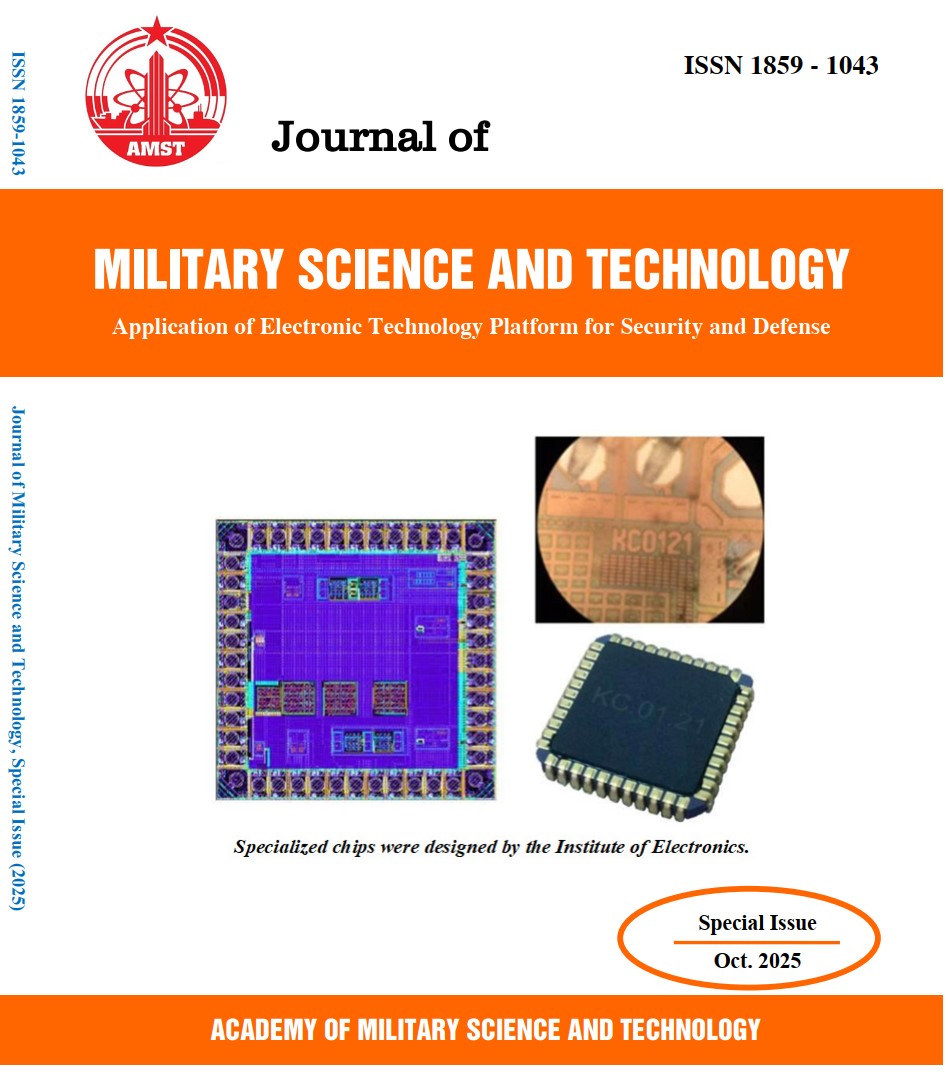Hệ thống truyền tin dưới nước cho vùng biển nước nông sử dụng điều chế FSK
DOI:
https://doi.org/10.54939/1859-1043.j.mst.IITE.2025.107-114Từ khóa:
Truyền thông dưới nước; Điều chế FSK; Bộ lọc phối hợp.Tóm tắt
Truyền thông dưới nước vẫn là một thách thức đáng kể do các yếu tố môi trường phức tạp như nhiễu, lan truyền đa đường và điều kiện kênh thay đổi theo thời gian. Bài báo này trình bày một hệ thống truyền thông dưới nước sử dụng điều chế Khóa dịch tần số (FSK) kết hợp với giải điều chế dựa trên bộ lọc phối hợp để giảm thiểu tác động của nhiễu trong môi trường nước nông, phù hợp với vùng biển Việt Nam. Bằng cách tận dụng khả năng phát hiện tín hiệu tối ưu của bộ lọc phối hợp trong các kênh nhiễu và thay đổi theo thời gian, hệ thống cải thiện đáng kể độ tin cậy của truyền thông trong điều kiện khắc nghiệt dưới nước. Kết quả mô phỏng chứng minh rằng hệ thống dựa trên FSK được đề xuất đạt được tỷ lệ lỗi bit (BER) dưới 10⁻³ ở tỷ lệ tín hiệu trên nhiễu (SNR) vượt quá 20 dB. Kết luận cho thấy điều chế FSK, kết hợp với giải điều chế bộ lọc phối hợp, là một giải pháp phối hợp cho truyền thông dưới nước trong các tình huống nước nông.
Tài liệu tham khảo
[1]. L. M. Brekhovskikh et al., “Fundamentals of ocean acoustics,” Springer, Berlin, no. 3rd ed., pp. 140–146, (2003).
[2]. Z. Li et al., “Underwater acoustic communications,” Nature reviews electrical engineering, Vol. 2, pp. 83–95, (2025).
[3]. M. M. Dawoud et al., “Experimental realization of ASK underwater digital acoustic communications system using error correcting codes,” International journal of electronics, Vol. 72, No. 2, pp. 183–196, (1992).
[4]. L. Araujo et al., “4-FSK high-speed underwater acoustic communication system,” OCEANS 2023 - Limerick, Limerick, Ireland, pp. 1–5, (2023).
[5]. L. M. Wolff et al., “Bitwise ranging through underwater acoustic communication with frequency hopped FSK utilizing the Goertzel algorithm,” OCEANS 2017 - Aberdeen, Aberdeen, UK, pp. 1–6, (2017).
A. Soulias et al., “Coherent phase shift keying (PSK) modulation using low-power micro-controllers for underwater acoustic communications,” OCEANS 2022, Hampton Roads, VA, USA, pp. 1–6, (2022).
[6]. Deshpande et al., “Underwater acoustic OFDM systems using deep neural network,” 3rd international conference on intelligent engineering and management (ICIEM), London, United Kingdom, pp. 195–200, (2022).
[7]. S. Zhou et al., “OFDM for underwater acoustic communications,” John Wiley Sons, Ltd, Vol. 9781118458860, pp. 1–386, (2014).
[8]. Tran Cao Quyen, “Nâng cao tốc độ truyền tin trong một kênh nước biển nông thuộc vịnh Bắc Bộ của Việt Nam dùng điều chế OFDM,” National Conference on Electronics, Communications and Information Technology, (2015) (in Vietnamese).
[9]. Y. T. Chan et al., “Comparison of two FFT-based demodulation schemes for M-ary FSK,” MILCOM 92 conference record, San Diego, CA, USA, Vol. 2, pp. 603–607, (1992).
[10]. W. Xiang et al., “FPGA-based two-dimensional matched filter design for vein imaging systems,” IEEE journal of translational engineering in health and medicine, Vol. 9, Art. no. 1800510, (2021).
[11]. J. Kaur et al., “Performance evaluation of matched filter detection using QAM technique in CR networks in different channel conditions,” IEEE 11th Uttar Pradesh section international conference on electrical, electronics and computer engineering (UPCON), Lucknow, India, pp. 1–4, (2024).
[12]. M. B. Porter, “The BELLHOP manual and user’s guide: preliminary draft,” Heat, Light, and Sound Research, Inc., La Jolla, CA, USA, Tech. Rep., Vol. 260, (2011).
[13]. D. V. Ha et al., “Methods of designing shallow underwater acoustic channel simulators,” Acoustics Australia, pp. 439–448, (2016).







